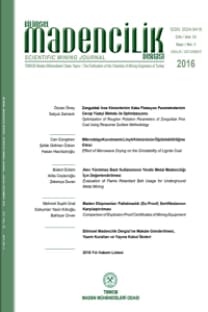ROTARİ SONDAJ MATKAPLARININ OPTİMUM SEÇİMİ VE İŞLETİLMESİ İÇİN YENİ BİR YÖNTEM
Bu çalışmada rotari sondaj matkaplarının seçimi ve kullanımını optimize eden yeni bir yöntem tanıtılmaktadır. Çalışmanın amacı, delinebilirliğe etki eden kayaç parametreleri ile gerçek boyutlu laboratuvar delik delme çalışmaları ve yerinde arazi uygulamalarından elde edilen datalar arasında regresyon analizi ile delme hızı tahmin modellerinin geliştirilmesidir. Bu çalışmada; öncelikle kayaç örneklerinin fiziksel ve mekanik özellikleri belirlenecektir. Kayaç koşullarına uygun olan farklı üreticilerin tavsiye ettikleri gerçek boyutlu matkaplar, bu matkapların kontrollü koşullarda test edilmesine imkân tanıyan yatay sondaj makinesinde sistematik olarak test edilip; delme hızı, matkap tasarımı ve işletme parametreleri en uygun matkabı bulmak amacıyla araştırılacaktır. Yatay sondaj makinesinde baskı kuvveti ve rotasyon parametrelerinin etkisi sistematik olarak test edilebilmektedir. Elde edilen verilerin detaylı analizleri ışığında matkapların spesifik delme hızı, spesifik aşınma ve spesifik enerji tüketimi belirlenmektedir
Anahtar Kelimeler:
Rotari sondaj, optimum matkap seçimi
A NEW METHOD TO OPTIMIZE THE ROTARY DRILL BIT SELECTION AND OPERATION
This paper reviews current state to the art to rotary drill bit selection and operation and also introduce a new method for optimizing this process. The research done so far are examined those are the rock properties affecting the drillability, the full scale laboratory studies, the observation of field practice and the regression analysis of this data to develop penetration rate estimation models. In the new method introduced at this paper; the physical and mechanical parameters of rock samples are firstly determined. Then, systematic drilling tests are carried out in Horizontal Drill Rig using real bits recommended by different manufacturers according to rock conditions. The relation between the penetration rate and the bit design and operational parameters are investigated to find the most suitable bit. In the light of data produced the detailed analysis are carried out to define the specific penetration rate, specific wear rate and specific energy consumption for different bits
Keywords:
Rotary drilling, optimum bit selection,
___
- Hughes, B., 1989. Baker Hughes mining tools product catalogue, Baker Hughes, Houston, Texas, s.1-17.
- Bilgesu, H.I., Al-Rashidi, A.F., Aminian, K., Ameri, S., 2000. A new approach for drill-bit Selection, Journal of Petroleum Technology, 52, s.27-28.
- Borquez, G.V., 1981. Estimating drilling and blasting costs and analysis prediction model, Engineering and Mining Journal, January, s.83-89.
- Cooper, G.A., Peltier, B., 1986. Advanced techniques for laboratory full-scale drilling tests, IADC/SPE Drilling Conference, s. 479-488, Dallas-USA.
- Dumans, C.F.F., Maidla, E.E., 1990. PDC bit selection method through the analysis of past bit performance, SPE Latin American Petroleum Engineering Conference, s.1-6, Rio De Jenerio.
- Ergin, H., Kuzu, C., Balci, C., Tuncdemir, H., Bilgin, N., 2000. Optimum bit selection and operation for the rotary blasthole drilling using a horrizontal drilling rig (HDR) - A case study at KBI Murgul copper Mine, International Journal of Surface Mining, Reclamation and Environment, 14, 4, s.295-304.
- Eronini, I.E., Somerton, W.H., Auslander, D.M., 1982. A dynamic model for rotary rock drilling, Journal of Energy Resources Technology, 104, 2, s.108-120.
- Ersoy, A., 2003. Automatic drilling control based on mininmum drilling spesific energy using PDC and WC bits, Trans. Int. Min. Metall A, 112, s.86-96.
- Fear, M.J., Meany, N.C., Evans, J.M., 1994. An expert system for drill bit selection, IADC/SPE Drilling Conference, s.359-383.
- Hartman, H.L., 1962. Crater geometry relations in percussive drilling, Mine and Quarry Engineering, s.530-536.
- Hoseinie, S.H., Ataei, M., Osanloo, M., 2009. A new classification system for evaluating Rock penetrability, International Journal Rock Mechanization Mining Sciences, 46, s.1329-1340.
- Judzis, A., Bland, R.G., Curry, D.A., Black, A.D., Robertson, H.A., Meiners, M.J., Grant, T.C., 2007. Optimization of deep-drilling performance-benchmark testing drives ROP Improvements for bits and drilling fluids, SPE/IADC Drilling Conference and Exhibition, Amsterdam-Netherlands, s.25-39.
- Kok, M.V., Guzeloglu, L., Akin, S., 2008. Data base development for drilling bit selection, Energy Resources, 30, s.377-383.
- Koronka, F., Tacaks, F., Andras, I., 2009. The influence of Rock properties on the wear of mining tools for rotating drilling, Revisto Minerol, 9, s.20-24.
- Motahhari, H.R., Hareland, G., Nygaard, R., Bond, B., 2009. Method of optimizing motor and bit performance for maximum ROP, Journal of Canadian Petroleum Technology, 48, s.44-49.
- Opafunso, Z.O., Adebayo, B., 2008. Blast-hole cuttings: an indicator of drill bit wear in quarries, European Journal of Scientific Research, 20, s.721- 736.
- Paona, J., Bruce W.E., 1963. Drillability studies- diamond drilling, RI-USBM 6324.
- Praillet, D., 1990. Drilling a manufacturer's viewpoint, Mining Technology Int., s.73-82.
- Praillet, R., 1998. Blasthole drilling, Rotary drilling and the four kingdoms, World Mining Equipments, s.20- 23.
- Raymond, D.W., Elsayed, M.A., Polsky, Y., Kuszmaul, S.S., 2008. Laboratory simulation of drill bit dynamics using a model-based servohydraulic controller, Journal of Energy Resources Technology, 130, 4, s.1- 12.
- Rockmore Int. Co., 1996. Product Catalogue, Rockmore Int., s.1-18.
- Singh, T.N., Jain, A., Sarkar, K., 2009. Petrophysical parameters afecting the microbit drillability of rocks, Int. Journal Rock Mechanization Mining Seciences, 1, s.261-277.
- Thuro, K., Spaun, G., 1996. Introducing the 'Destruction Work' as a new rock property of toughness referring to drillability in conventional drill and blast tunnelling, Eurock'96-Prediction and Performance in Rock Mechanics and Rock Engineering, 2, s.707-713, Torino-Italy.
- Varel Co., 1991. Varel product catalogue-mining industrial Rock bits, Varel Manufacturing Co., s.1-17, Dallas-Texas.
- Walker-McDonald Mfg. Co., 1998. Rotary bits, Walker- McDonald. World Oil's, 2008. Drill Bit Classifier, Gulf Publishing Co., s.133-153, Houston, USA.
- ISSN: 2564-7024
- Yayın Aralığı: Yılda 4 Sayı
- Yayıncı: TMMOB Maden Mühendisleri Odası
Sayıdaki Diğer Makaleler
PATLATMA SONUÇLARININ ANALİZİNDE YERSEL LAZER TARAYICILARIN (LiDAR) KULLANIMI
İrfan Celal ENGİN, Norbert MAERZ
SİİRT-MADENKÖY BAKIR CEVHERİNİN FLOTASYON YÖNTEMİYLE ZENGİNLEŞTİRİLMESİ
ROTARİ SONDAJ MATKAPLARININ OPTİMUM SEÇİMİ VE İŞLETİLMESİ İÇİN YENİ BİR YÖNTEM
Hasan ERGİN, Ömür ACAROĞLU, Melis TOKER, Bahadır ERGENER, Deyvi AKKRİŞ
UZUNAYAK ÜRETİMİNDEKİ MEVCUT TEHLİKE KAYNAKLARININ İŞ GÜVENLİĞİ AÇISINDAN DEĞERLENDİRİLMESİ
M Kemal ÖZFIRAT, Mustafa Emre YETKİN, Ferhan ŞİMŞİR, Bayram KAHRAMAN
